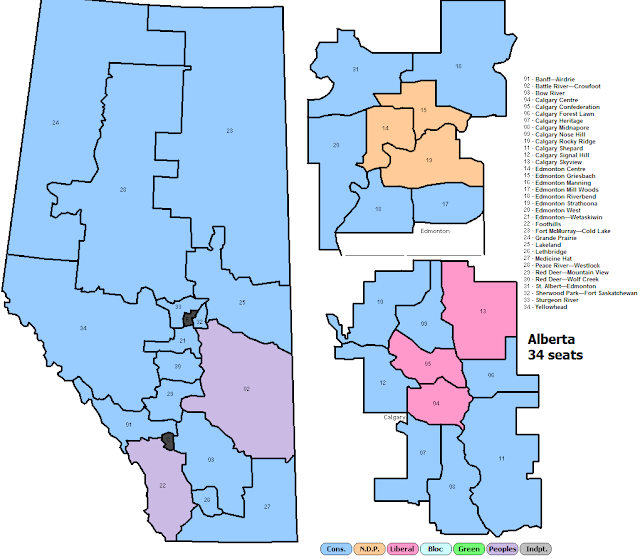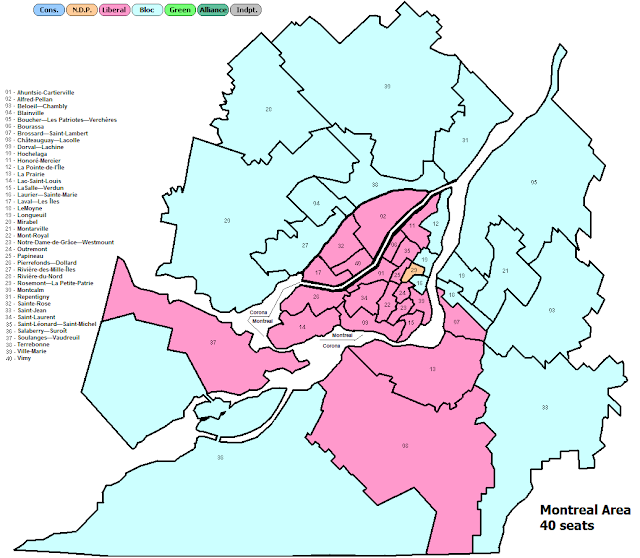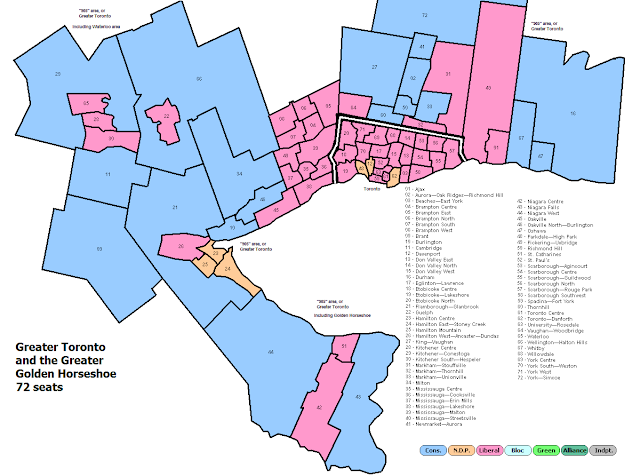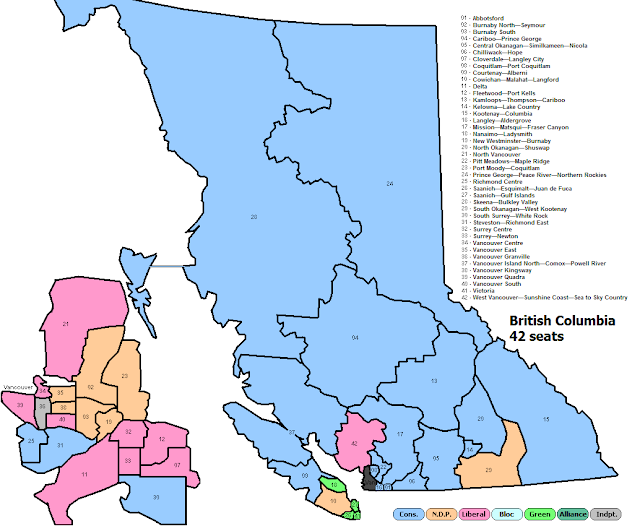One of the things I tried to do for a failed post was look at an alternate history of how Canada would look, using real Canadian elections, but treating Western Canada, and the rest of Canada, as two different countries. This failed for a number of reasons, but one was simply that it didn't show what it was supposed to; that there's a massive split between the two. The massive split simply didn't manifest in the way I expected. In fact, I got more mileage by simply removing Alberta. Without Alberta, Harper's 2011 majority becomes a minority. In 2006 the Liberals take the most seats instead of the Tories. Reform finishes behind the Bloc in 1997. Joe Clark's 1979 margin of victory is reduced to a single seat.
Additionally, part of my 'alternate history' project, included combing the vote of the left of centre parties in Western Canada. When you do that, you end up with the following maps:
Which works out to a centre-left Majority of one.
It may be unfair to do a 100% vote conversion of all 3 centre-left parties VS the various right-wing parties (CPC, PPC, CHP, Libertarians) but it does show something that I think a lot of people miss.
The major split isn't between Western Canada and the rest of Canada.
It is between Alberta and BC.
Lets look at federal popular vote for the Tories, Social Credit, Reform, Canadian Alliance in all elections, and the "proto-reform" Confederation of Regions party, in 1984, in the two provinces. Lets start in 1968, which is often a place I start as it is by this point that "national" media networks have taken hold in Canada, and the first one with a debate. Combining the vote for the above parties (in this case, just the Tories and Social Credit) gives us the following:
25.3% BC // AB 52.9% - 1968
Continuing we get results as follows:
35.6% BC // AB 62.1% - 1972
43.1% BC // AB 64.6% - 1974
44.5% BC // AB 66.6% - 1979
41.6% BC // AB 65.9% - 1980
46.6% BC // AB 68.8% - 1984
40.1% BC // AB 67.2% - 1988
49.9% BC // AB 66.9% - 1993
49.3% BC // AB 69.0% - 1997
56.7% BC // AB 72.4% - 2000
36.3% BC // AB 61.7% - 2004
37.3% BC // AB 65.0% - 2006
44.4% BC // AB 64.6% - 2008
45.5% BC // AB 66.8% - 2011
30.0% BC // AB 59.5% - 2015
34.1% BC // AB 69.2% - 2019
With this I've done additional math. I've taken the BC result and divided into the Alberta result to provide a percentage; it is a ratio showing the comparison between the two. For example, in 1968, the right-wing parties took 25.3% of the vote in BC vs 52.9% in Alberta. 235 is 47.83% of 529, hence our number. The results are as follows:
57.33% - 1972
66.72% - 1974
66.82% - 1979
63.13% - 1980
67.73% - 1984
59.67% - 1988
74.59% - 1993
71.45% - 1997
78.31% - 2000
58.83% - 2004
57.38% - 2006
68.73% - 2008
68.11% - 2011
50.42% - 2015
49.28% - 2019
You can see a clear trend here. First, note that when the Reform Alliance did well, from 1993 through 2000, BC was consistently hitting above 70%. Normally the ratio seemed to hover closer to 60%, popping out of that range from time to time, but staying usually within it.
Note the sudden and stark change in 2015.
Note how the gap only grew in 2019.
Lets also look at some provincial election results from BC, in particular, the popular vote totals for Social Credit.
47% - 1969
31% - 1972
49% - 1975
48% - 1979
50% - 1983
49% - 1986
Excepting their loss in 1972, these results are fairly consistent, and are similar to, if not better than, the federal 'right-wing' results in the province.
In 1987, the BC Liberals elected Gordon Campbell as leader, and thus the party shifted to the right. The combined BCL/SC vote total was 57%, with 33% for the Liberals and 24% for Social Credit. The 1996 election would see a combined BCL+Reform vote total of 51%, with 42% for BCL and 9% for Reform. By 2001, although other right-wing parties continued to exist, the BC Liberals had become dominant, and they won 58% of the vote on their own. Tangent of a reminder, it was this government that introduced fixed election dates, now standard in nearly every province in Canada.
By 2005, things begun to change. BCL was down to 46%, while the combined NDP+Green total was 51%. By 2008, it was the BC Liberals themselves who introduced a carbon tax. The Environment simply was becoming a much more important topic of discussion and thought. The 2009 BC election saw the Liberals steady at 46% while the NDP and Greens combined to reach 50%. 2013 would see 44% for the Liberals, while 2017 would see them drop to 40%, but the combined NDP+Green vote increase to 57%
Simply put, the environment is important to BC Voters.
It is important to Canadian voters as a whole as well, but has yet to make similar inroads into Alberta's political culture.
We can see this across Canada. Lets look at the results for provincial Greens in the most recent provincial elections:
BC - 16.8%
AB - 0.4%
SK - 1.8%
MB - 6.4%
ON - 4.6%
QC - 1.7%
NB - 11.9%
NS - 2.8%
PE - 30.6%
NL - 0.0% (no provincial party)
Note that Quebec provincial parties tend to be more friendly towards the environment, though not always, and that this can explain the low number there. In Ontario, in past elections, the Greens have taken upwards of 8% of the vote, and, in the most recent election, gained a seat in the Legislature.
In the federal election, the Greens managed to take under 3% of the vote in both Alberta and Saskatchewan. Their next worst showing was in Newfoundland and Labrador, which, has a particular distaste of the party which goes back a decade to arguments about the seal hunt. Beyond this, the worst showing was Quebec at 4%, Manitoba at 5%, and Ontario at 6%. Results in British Columbia, Nova Scotia, New Brunswick, and Prince Edward Island, all topped 10% of the vote. In fact the Greens received more votes from New Brunswick alone than they did from Alberta and Saskatchewan combined.
What we are seeing thus is not a divide between Western Canada and "Eastern" or the rest of Canada. It is a divide between Alberta (and large parts of Saskatchewan, as well as Newfoundland) against the remainder of Canada, especially parts of British Columbia, and the environmentally conscious urban centres of Toronto and Montreal.
This is not an issue that can simply be fixed by tapping the policy dials. This is an issue that will only resolve itself when one side, the other side, or both sides, decide it is time to either give in, or to compromise.
It is quite likely that in an attempt to hold on to votes in the other provinces, the Tories will adopt a tone less friendly towards Alberta and Saskatchewan and their anti-environment stances. This would give a chance for a new anti-environment party to pop up, or, for an existing small party to take on and champion the cause (for example, the Peoples Party)
Given the trend issues like this tend to take, it is my guess that in time, Alberta and Saskatchewan will come around to the trend that prevails in the rest of the country. It's only a matter of when that happens and how stressful of a process it will be.

























































